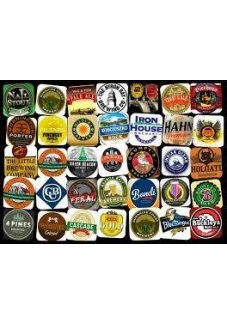BEERS ~ CIDERS
Beer from all over the World.....the variety of beers brewed throughout the world is impressively large. You need only think of the number one beer country, Germany, or even a small country like Belgium, which is unique both in beer consumption per head and in the variety of beers available. Many countries which are not normally thought of as br...
Beer from all over the World.....the variety of beers brewed throughout the world is impressively large. You need only think of the number one beer country, Germany, or even a small country like Belgium, which is unique both in beer consumption per head and in the variety of beers available. Many countries which are not normally thought of as brewing nations, perhaps priding themselves more on their reputation as wine producers, also have breweries that inspire intense loyalty among native beer drinkers. Many more beers have never strayed far from the borders of their country of origin and some are known only as regional specialties.
BEERS ~ CIDERS There are no products in this category
Subcategories
-
Australian Beers
Beer is said to have made its appearance in Australia with the 'First Fleet' in 1788. Admittedly the vessels were transporting convicts but warders, sailors and officers will probably have been allowed some beer. Because they could not rely on supplies from the home country, the new settlers soon developed their own beer production, which was closely to the British brewing traditions. In 1887 the American Foster brothers, who ran a company producing refrigerators, set up a brewery in Melbourne where they produced Lager beer. Although they sold the brewery the following year, the taste had quickly caught on because people much appreciated this refreshing drink in the country's hot climate. Its popularity rapidly spread throughout the country, although some very tasty ales, often in the form of bitter, also remained popular.
Of course, there is nothing more important to Australians than beer. Beer defines our state borders and lubricates the hinges of social and sometimes sexual relationships. It's everything . Even sport would be meaningless without beer - the drinking and the sponsorship. Beer defines us - both as a nation and individually. As Australians, we are very much what we drink.
-
Brewed Beers
Brewing is the production of beer by steeping a starch source (commonly cereal grains, the most popular of which is barley) in water and fermenting the resulting sweet liquid with yeast. It may be done in a brewery by a commercial brewer, at home by a homebrewer, or by a variety of traditional methods such as communally by the indigenous peoples in Brazil when making cauim. Brewing has taken place since around the 6th millennium BC, and archaeological evidence suggests that emerging civilizations including ancient Egypt and Mesopotamia brewed beer. Since the nineteenth century the brewing industry has been part of most western economies.
The basic ingredients of beer are water and a fermentable starch source such as malted barley. Most beer is fermented with a brewer's yeast and flavoured with hops. Less widely used starch sources include millet, sorghum and cassava. Secondary sources (adjuncts), such as maize (corn), rice, or sugar, may also be used, sometimes to reduce cost, or to add a feature, such as adding wheat to aid in retaining the foamy head of the beer. The proportion of each starch source in a beer recipe is collectively called the grain bill.
Steps in the brewing process include malting, milling, mashing, lautering, boiling, fermenting, conditioning, filtering, and packaging. There are three main fermentation methods, warm, cool and spontaneous. Fermentation may take place in an open or closed fermenting vessel; a secondary fermentation may also occur in the cask or bottle. There are several additional brewing methods, such as barrel aging, double dropping, and Yorkshire Square.
-
International Beers
International beers encompass the whole world but its really Europe where the heart beats.The birthplace of beer may have been the Middle East and Egypt, but it has been in Europe that it has developed its fullness and rich variety which has then spread all over the world.
This is also because the politically and culturally divided Ancient world was also divided in he types of flavours it enjoyed. For this reason the countries of Europe have throughout the centuries given rise to a wide variety of very different brewing traditions, resulting in an amazingly rich palette of tastes and types. As beer made its triumphant progress into other continents, so did individual facets of European brewing.
In the United States, for example, people tend to prefer German and British beers are the most popular while in the Far East German beers are generally preferred, except in Indonesia where the taste is for Dutch beers. Quality also plays a major part here and Europe has something for everyone. Bohemia now Czech Republic started the pilsner revolution in the mid 19th century.
Centuries earlier Germany had decreed its Purity Law, brewing a wide range of beers from Bock to Kolsch, from Alt to White Beer. Belgium and Holland display an interesting variety, ranging from Abbey beers to spiced and fruit beers. Britannia rules not only the waves but also the Ales and Stouts, Bitters and Porters.
-
Stout Beers
Stout is a top fermented English, Scottish or Irish beer with an original gravity of about 25 percent. It is a strong beer which is almost black and with an intensely bitter taste. The strong flavour of barley is the result of the addition of roasted malt. It is a form of Porter whose roasted malt taste can vary sweet, dry to full bodied. To distinguish a Porter from a Stout, all you need do is place a full glass in front of a light. Porter will look transparent with a reddish colour while Stout will remain black and opaque. The Sweeter versions of Stout, often with a slightly aftertaste, are mainly English while dry Stouts are predominantly Scottish in origin. The sweeter Stouts were once known as Milk Stouts, but this name may no longer used because of the risk of causing confusion to the consumer, the term "Sweet Stout" is now used instead. The name 'Stout" is derived from Stout Porter, meaning strong Porter, which in the course of time was abbreviated to "Stout'. The Stout best known all over the world is the Irish Guinness Stout with its distinctive sharp, bitter taste. In Britain this type is often called "Extra Stout" or "Dry Stout". Very strong Stouts, known as "Imperial" or "Russian Stout", are also found in Britain. All Stout have their own particular bouquet. A Stout should always be poured very slowly so that the head has time to develop. It is a good idea to pause a little when pouring, in two stages the head will be denser and creamier. A Stout from the bottle will have a more solid head and a more natural taste than one delivered from a keg by compressed gas.
In the latter part of the 19th century, Stout carried a reputation as a health-giving drink - sometimes recommended for nursing mothers and athletes. Today, although not usually prescribed by doctors! - Stout’s popularity is on the up again. New varieties and expressions are being made available, as brewers experiment to enhance the chocolate, coffee, and spicy notes of malt’s wider profiles. -
Ciders
Cider is an alcoholic beverage made from the fermented juice of apples.The juice of any variety of apple can be used to make cider, but cider apples are best. The addition of sugar or extra fruit before a second fermentation increases the alcoholic content of the resulting beverage. Cider is popular in the United Kingdom, especially in the West Country, and widely available. The UK has the world's highest per capita consumption, as well as its largest cider-producing companies.Cider is also popular in other European countries including Ireland, Portugal (mainly in Minho and Madeira), France (in particular Brittany and Normandy), northern Italy (Piedmont and Friuli), and Spain (especially Asturias and the Basque Country). Central Europe also has its own types of cider with Rhineland-Palatinate and Hesse producing a particularly tart version known as Apfelwein.
Cider alcohol content varies from 1.2% ABV to 8.5% or more in traditional English ciders, and 3.5% to 12% in continental ciders. Under UK law, it must contain at least 35% apple juice (fresh or from concentrate), although CAMRA says that "real cider" must be at least 90% fresh apple juice. In the US, there is a 50% minimum. In France, cider must be made solely from apples.
The flavour of cider varies. Ciders can be classified from dry to sweet. Their appearance ranges from cloudy with sediment to completely clear, and their colour ranges from almost clear to amber to brown. The variations in clarity and colour are mostly due to filtering between pressing and fermentation. Some apple varieties will produce a clear cider without any need for filtration. Both sparkling and still ciders are made; the sparkling variety is the more common.
Modern, mass-produced ciders closely resemble sparkling wine in appearance. More traditional brands tend to be darker and cloudier. They are often stronger than the mass-produced varieties and taste more strongly of apples. Almost colourless, white cider has the same apple juice content as conventional cider but is harder to create because the cider maker has to blend various apples to create a clearer liquid. White ciders tend to be sweeter and more refreshing. They are typically 7-8 % ABV in strength. Black cider, by contrast, is dry amber premium cider which has an alcohol content of 7-8 % ABV. The descriptor black usually comes after the brand name such as Union Black and Barnstormer Black.
Although Cider makes the perfect aperitif, the range of styles available means it can equally be at home with a versatile range of foods. The fresher Cider styles are ideal with light foods such as seafood, while the more complex Ciders are a better match with red and white meats.
ABN: 11 806 263 393
Liquor Licenses
337 526 06
360 674 16





